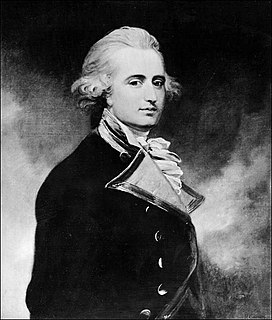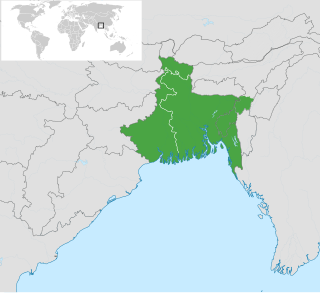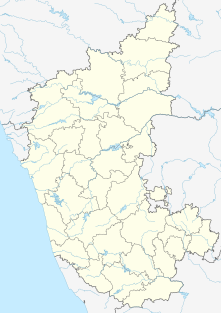Edward Montagu (1755–1799), Indian officer, was youngest son of Admiral John Montagu, and brother to Admiral Sir George Montagu and Captain James Montagu.

Admiral John Montagu (1719–1795) was an English naval officer and colonial governor of Newfoundland.

Admiral Sir George Montagu was a Royal Navy officer, the second son of Admiral John Montagu, and the brother of Captain James Montagu and Lieutenant-Colonel Edward Montagu.
James Montagu (1752–1794), captain in the Royal Navy, third son of Admiral John Montagu, and brother of Admiral George Montagu and of Edward Montagu (1755–1799), was born on 12 August 1752.
Educated at the Royal Academy of Woolwich, he went out to Bengal as an East India cadet in 1770. There being no commission vacant on his arrival, he was first placed in the ‘select picket,’ a military body composed of the cadets then present at Calcutta.

Woolwich is a district of south-east London, England, within the Royal Borough of Greenwich. Originally a town in Kent, it has been part of the London metropolitan area since the 19th century. In 1965, most of the former Metropolitan Borough of Woolwich became part of Greenwich Borough, of which it remains the administrative centre.

Bengal is a geopolitical, cultural and historical region in South Asia, specifically in the eastern part of the Indian subcontinent at the apex of the Bay of Bengal. Geographically, it is made up by the Ganges-Brahmaputra delta system, the largest such formation in the world; along with mountains in its north bordering the Himalayan states of Nepal and Bhutan and east bordering Burma.
On 16 May 1772 he was admitted into the Bengal Artillery as lieutenant-fireworker, and by 24 Sept. 1777 he had risen to the rank of first-lieutenant of artillery. He was attached to Brigadier-general Thomas Goddard's army during the Mahratta campaign of 1781, and was successfully employed against certain Mahratta forts on the Rohilcund border, on one occasion being severely wounded in the face by an arrow.
Lieutenant-fireworker was an officer rank in the British Royal Artillery, ranking below second lieutenant.

Artillery is a class of heavy military weapons built to fire munitions far beyond the range and power of infantry's small arms. Early artillery development focused on the ability to breach defensive walls, and fortifications during sieges, and led to heavy, fairly immobile siege engines. As technology improved, lighter, more mobile field artillery cannons developed for battlefield use. This development continues today; modern self-propelled artillery vehicles are highly mobile weapons of great versatility providing the large share of an army's total firepower.
In 1782 he accompanied Colonel Pearce's detachment, sent to join Sir Eyre Coote (1726–1783), then engaged against Haider Ali and his French allies in the Carnatic, and in 1783 he commanded the English artillery in the siege unsuccessfully attempted by General James Stuart of Cuddalore, a strong Carnatic fortress then held by the French. On the conclusion of the war in the Carnatic (1784), Montagu returned to Bengal. He was promoted to a captaincy on 13 Oct. 1784. He took a prominent part in the invasion of Mysore, conducted by Lord Cornwallis in 1791. He superintended the artillery employed in the sieges of Nandidrúg (captured 19 Oct. 1791) and Savandrúg (captured 21 Dec. 1791). For his skill and vigour Montagu received special commendation from Lord Cornwallis. The war concluded in favour of the English in 1792. On 1 March 1794 Montagu was made lieutenant-colonel, being now third on the list of Bengal artillery officers.

Lieutenant-General Sir Eyre Coote, KB was a British soldier and politician who sat in the House of Commons from 1768 to 1780. He is best known for his many years of service with the British Army in India. His victory at the Battle of Wandiwash is considered a decisive turning point in the struggle for control in India between Britain and France. He was known by his sepoy troops as Coote Bahadur.

Hyder Ali, Haidarālī was the Sultan and de facto ruler of the Kingdom of Mysore in southern India. Born as Sayyid wal Sharif Hyder Ali Khan, he distinguished himself militarily, eventually drawing the attention of Mysore's rulers. Rising to the post of Dalavayi (commander-in-chief) to Krishnaraja Wodeyar II, he came to dominate the titular monarch and the Mysore government. He became the de facto ruler of Mysore as Sarvadhikari by 1761. He offered strong resistance against the military advances of the British East India Company during the First and Second Anglo–Mysore Wars, and he was the innovator of military use of the iron-cased Mysorean rockets. He also significantly developed Mysore's economy.

The Kingdom of Mysore was a kingdom in southern India, traditionally believed to have been founded in 1399 in the vicinity of the modern city of Mysore. The kingdom, which was ruled by the Wodeyar family, initially served as a vassal state of the Vijayanagara Empire. With the decline of the Vijayanagara Empire, the kingdom became independent. The 17th century saw a steady expansion of its territory and during the rule of Narasaraja Wodeyar I and Chikka Devaraja Wodeyar, the kingdom annexed large expanses of what is now southern Karnataka and parts of Tamil Nadu to become a powerful state in the southern Deccan.
In the final war against Tipu, sultan of Mysore (1799), Montagu, as commander of the Bengal artillery, accompanied the army under General Harris which was directed to invade Mysore from Madras. On 9 April 1799 Seringapatam, the Mysore capital, was formally invested. On 2 May Montagu, while directing his battery, was struck in the shoulder by a cannon-shot from the enemy's lines. He died from the effects of the wound on 8 May 1799.

Tipu Sultan, also known as the Tipu sahab was a ruler of the Kingdom of Mysore. He was the eldest son of Sultan Hyder Ali of Mysore. Tipu Sultan introduced a number of administrative innovations during his rule, including his coinage, a new Mauludi lunisolar calendar, and a new land revenue system which initiated the growth of the Mysore silk industry. He expanded the iron-cased Mysorean rockets and commissioned the military manual Fathul Mujahidin, and is considered a pioneer in the use of rocket artillery. He deployed the rockets against advances of British forces and their allies during the Anglo-Mysore Wars, including the Battle of Pollilur and Siege of Seringapatam. He also embarked on an ambitious economic development program that established Mysore as a major economic power, with some of the world's highest real wages and living standards in the late 18th century.

George Harris, 1st Baron Harris GCB was a British soldier.

Mysore, officially Mysuru, is a city in the state of Karnataka, India. It is located in the foothills of the Chamundi Hills about 145.2 km (90 mi) towards the southwest of Bangalore and spread across an area of 152 km2 (59 sq mi). Mysore City Corporation is responsible for the civic administration of the city, which is also the headquarters of the Mysore district and the Mysore division.









